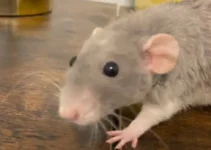Mice may be annoying critters capable of expensive damage. However, it’s thoughtful to dispose of a live mouse without killing it.
If your cage trap caught a couple of mice, consider humanely getting rid of it them by releasing them outside, advisably 2-5 miles away from your house. Otherwise, you can get rid of the poor critter by drowning or asphyxiating it.

How to dispose of a live mouse
It’s okay to release the mouse outside if you believe that like most living things, they too deserve to live. Consider the steps below:
1. Wear your hand gloves
You should use gloves when handling a live mouse trap, even if you won’t be handling the critter itself. By so doing, you are protected from any potential illnesses the mouse might be carrying.
Make sure to cover the cage trap so that the mouse can’t see you. Mice are timid animals who will try to flee more readily when you make eye contact.
If you caught the mouse with a glue trap, you can release it by pouring VCO (Virgin Coconut Oil) or any other type of vegetable oil into the trap. Meanwhile, VCO consists of 90–95% saturated triglycerides that have a moisturizing effect on the skin—referencing Anti-Aging Effects of a Serum Based on Coconut Oil Combined with Deer Antler Stem Cell Extract on a Mouse Model of Skin Aging.
After releasing the mouse, do not forget to thoroughly wash the trap with soap and water if it’s reusable like most bucket traps, and not a glue trap. Otherwise, dispose of it.
2. Decide a safe place to release it
You don’t want the mouse to return and continue the damage, so release it as far as 2-5 miles from your home. Some experts argue that a 100-yard distance is not enough as the rodent may retrace your home even before you.
If you live in a city, look for a park or other open places where you have garbage around and let the mouse go. Even any woody location will do.
Make sure you have a physical barrier between you and the mouse once you’ve released it—you could use a log to keep it from attacking you in defense since you are a threat.
3. Release the critter back in the wild
When releasing the live mouse, leave it some food to discourage it from following you, as well as sustain it until it adapts to the new environment. Also, leave pieces of paper towel and torn fabric for nesting purposes.
Move away immediately after releasing the mouse to allow it some space to scurry away. The mouse can get scared if you hang around for too long and try to attack you as a form of self-defense.
After releasing the mouse, be sure to thoroughly wash your hands and gloves with soap and warm water.
4. Euthanize the mouse
Exposure to (carbon dioxide) CO2 without removing the mice from the cage is a quick and humane method of euthanasia. Thus, you want to expose the mouse to CO2 which leads to deep narcosis that resembles but is different from death. Moreover, according to the NIH, carbon dioxide inhalation is a common method of putting down mice and other rodents like rats, guinea pigs, and hamsters. The American Veterinary Medical Association also approves CO2 euthanasia (see the AVMA euthanasia guidelines).
Read also: did you recently see one mouse outside?
How far away to release a mouse?
Release a captured mouse at least 5 miles from your house to be sure that it won’t return to your house. If you reside in a rural, you might be allowed to release the mouse at least 100 yards from where you caught it closer to your house. You can always consult a local expert for guidance if you are uncertain how far away to release it.
Where to release mouse
Common places to release a live mouse are:
Into the wild
Releasing a live mouse into the wild is a compassionate method to dispose of it. It offers the animal a chance to continue living in its natural environment.
It is not enough to merely let the mouse go into the wild as it could become vulnerable to human or animal predators. Instead, release it far from structures or busy roadways.
Parks littered with garbage
Mice will thrive in public parks where they may feed from trash and live fairly comfortably. People scatter food scraps all over the typical park and mice as wild creatures will survive with those chunks.
While you release the critter far from your property, you don’t want it near another person’s home. Meanwhile, the drawback of releasing mice in a new environment is that it could stress the animal. Being released into an unfamiliar environment can be frightening for mice. They are creatures of habit and will need some time to adapt which is why you should leave them some food.
What happens if you don’t get rid of mice?
While overlooking that mice infestation in your home, think about the consequences:
1. Mice reproduce rapidly
They procreate very quickly. Mice can gestate for between 19 and 21 days and a mouse can reproduce anywhere between 5 and 10 times each year with instant pregnancy. Since they recreate rapidly, it’s not unusual to have litters only 25 days apart.
2. Expensive damages
When mice get into cabinets, they often ruin home furniture by gnawing on them. They also attack your storage bags and even plastic containers. Mice will chew on wires, books, and toys and litter the property with their urine and feces.
3. Disease problem
You risk infection with mice in your home. Mice are known carriers of diseases such as HPS (hantavirus), Leptospirosis, lymphocytic choriomeningitis, plague, and typhus. The best way to protect yourself from these diseases is to keep mice and rats out of your home—CDC.
Cleaning up after a mouse
After releasing the mouse, protect yourself and your family with these simple steps:
1. Put on a mask and gloves.
You need gloves and a mask when cleaning up to reduce the chance of inhaling mice evidence during cleaning and becoming infected.
2. Disinfect the area
Start by wiping the areas where the mouse was caught using a disinfectant to stop the possible spread of diseases if the mouse was a carrier. You can use a bleach solution or any recommended cleaning solution from your local store.
Make sure to clean all surfaces, including counters, floors, and walls, where the mouse may have touched. Additionally, clean the cages or traps used and dispose of them if they are no longer reusable.
3. Wash your hands
Even after wearing gloves during the cleanup, it’s necessary to wash your hands with soap and water. Any bacteria or viruses that may have been on your gloves will be eliminated in the process. Make sure to scrub your hands for at least 20 seconds with gentle soap and warm water.
4. Dispose of necessary items
Dispose of the mouse evidence (feces, urine, saliva, and nesting materials) after the disinfection procedure. Leave them in a sealed plastic bag and discard them in an airtight trash can.


![Rat in Garden in Daylight [What Does It Mean?] Rat in Garden in Daylight [What Does It Mean?]](https://fodcas.com/wp-content/uploads/2023/07/PicsArt_07-12-09.59.45.webp)